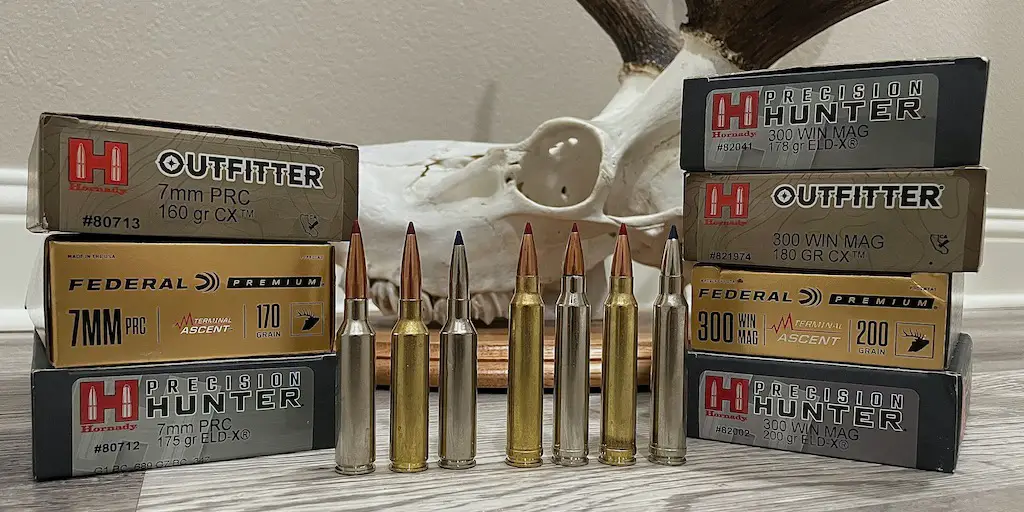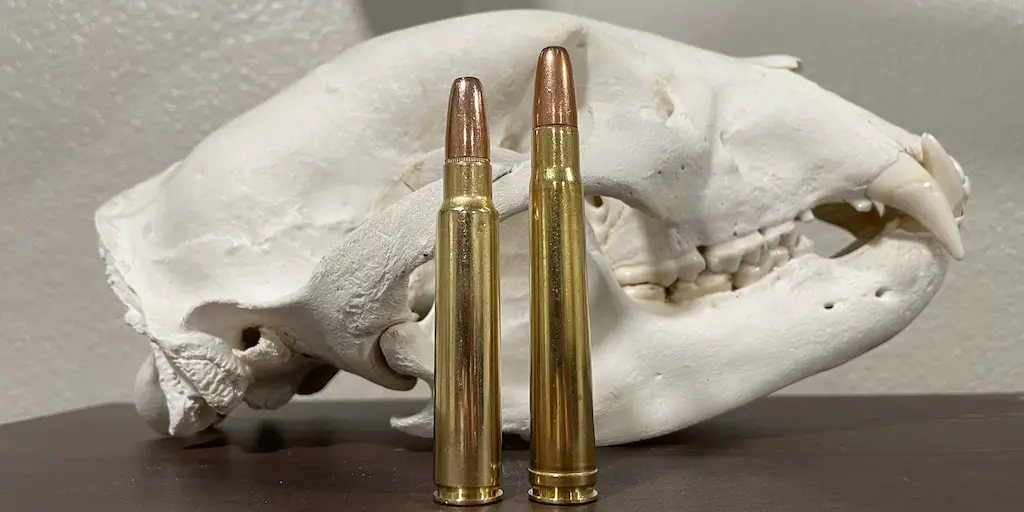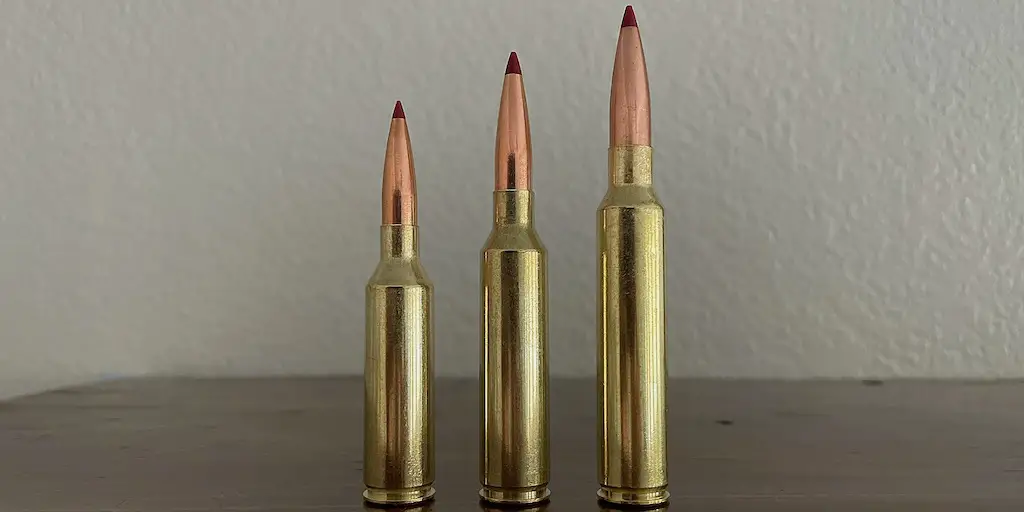Trying to decide between the 7mm PRC vs 300 Win Mag cartridges for a new hunting rifle? Here’s what you need to know about them.
On one hand, no list of big game hunting cartridges is complete without the 300 Winchester Magnum and it consistently ranks among the most popular calibers used for hunting all manner of medium and big game. This is for a good reason: the 300 Win Mag has developed a sterling reputation afield across the whole spectrum of game in the 60+ years the cartridge has been in use.
On the other hand, the brand new 7mm Precision Rifle Cartridge has taken the hunting world by storm since coming on the scene in 2023.
I’m not exaggerating when I say that I’ve never seen a cartridge make as big of a splash as the 7mm PRC did when it was introduced by Hornady. Even though it’s still very new, the 7mm PRC has also quickly developed a great reputation as an accurate and effective big game hunting round.
With those things in mind, it’s not surprising that many hunters looking for a new hunting rifle are considering the 300 Winchester Magnum and the 7mm Precision Rifle Cartridge.
Both offer certain advantages to hunters and there is a big overlap in their capabilities, but there are some important differences between the 7mm PRC vs 300 Win Mag cartridges you should keep in mind.
In this article, I investigate the 7mm PRC vs 300 Win Mag and provide insight on the pros and cons of each rifle cartridge along with recommendations on which one is best suited for various hunting situations so you can decide which one will work best for your individual needs.
History Of The 300 Winchester Magnum & 7mm PRC
The years right after World War II were a true renaissance of civilian firearm and cartridge development in the United States after the manufacturing base that produced gigantic quantities of weapons for military use during the 1940s transitioned back to firearm and ammunition development for civilians.
For instance, that time period saw a flood of new centerfire rifle cartridges like the .223 Remington, .243 Winchester, .280 Remington, and .308 Winchester hit the market.
It’s true that Roy Weatherby released his first handful of magnum cartridges that bore his name during the 1940s.
However, the modern “Magnum Era” really hit its stride when Winchester continued similar development in the 1950s and 1960s when they introduced their own line of new belted magnum cartridges utilizing a modified .375 H&H Magnum case.
The heavy hitting big bore .458 Winchester Magnum came on the scene first in 1956. Winchester then subsequently released their .338 Winchester Magnum and the .264 Winchester Magnum cartridges during the next couple of years as well.
Those three cartridges all utilized a .375 H&H Magnum case necked down (or up, in the case of the .458 Win Mag) and shortened from 2.85″ to 2.5″ long. Designers at Winchester used those shortened cases so all three cartridges would fit in a standard length rifle action (same as the .30-06 and 270) instead of the longer magnum length action required by the original .375 H&H cartridge.
While they were far from perfect, the 264 Win Mag, 338 Win Mag, and 458 Win Mag were all fairly commercially successful to one degree or another. Winchester didn’t stop with those three cartridges though.
Winchester really hit things out of the park when they rolled out the .300 Winchester Magnum (also known as the .300 Win Mag or .300 WM) in 1963.
Built using a modified .338 Winchester Magnum case necked down to use a .30 caliber bullet, the .300 Winchester Magnum basically duplicated the performance of the old .300 H&H Magnum and could fire a 180-grain bullet at nearly 3,000fps.
Unlike the H&H .30 caliber magnum though, the .300 Win Mag utilized a shorter case that fit in a standard length rifle action like the other new Winchester belted magnums as well as the new 7mm Remington Magnum released in 1962.
Offering a dramatic improvement in performance over the venerable .30-06 Springfield that also compared favorably to the 7mm Rem Mag in many areas, the .300 Win Mag was an almost instant commercial success for Winchester and the cartridge remains extremely popular to this day.
You can learn more about the 300 Winchester Magnum and how the that cartridge compares to other cartridges like the 6.5 Creedmoor, 7mm Remington Magnum, 308 Winchester, 30-06 Springfield, and 28 Nosler in the articles below:
6.5 Creedmoor vs 300 Win Mag Comparison
7mm Rem Mag vs 300 Win Mag Comparison
308 vs 30-06 vs 300 Win Mag Comparison
300 Win Mag vs 28 Nosler Comparison
Now let’s shift gears and focus on today’s new hotness: the 7mm Precision Rifle Cartridge from Hornady.
We first need to talk a little about the forerunners of the 7mm PRC: the 6.5 PRC and the 300 PRC.
The 6.5 PRC and the 300 PRC were the first two members of the Precision Rifle Cartridge family and both hit the market around the same time a few years ago.
While these cartridges may not look related at first glance, both use the 375 Ruger as a parent case.
First introduced back in 2007 as the result of a collaboration between Hornady and Ruger, the .375 Ruger was built to deliver the same sort of performance as the legendary 375 H&H Magnum. However, the 375 Ruger does so out of a standard length rifle action instead of requiring a longer magnum length action like the 375 H&H.
This allowed gun manufacturers to build rifles delivering 375 H&H level performance (which is renowned all over the world), but do so using smaller, handier, and less expensive rifles.
A couple of factors allow the 375 Ruger to achieve those ballistics.
First, the 375 Ruger has the same .532″ case head diameter as the .375 H&H, so both cartridges use a standard magnum bolt face. However, unlike the .375 H&H (and cartridges like the 7mm Remington Magnum and .300 Winchester Magnum descended from it) the .375 Ruger is a beltless cartridge with minimal taper, so the actual body of the .375 Ruger case is larger in diameter than the .375 H&H.
This results in a slight increase in case capacity for the 375 Ruger vs the 375 H&H, even though the 375 Ruger is a little shorter overall.
Anyway, the 6.5 PRC and 300 PRC both utilize modified 375 Ruger cases and have an overall design that’s optimized for performance with long, high BC bullets. Plus, both cartridges also incorporate some modern cartridge design features to improve their overall accuracy potential.
As you might guess from their names, the 6.5 PRC is a short action cartridge that shoots 6.5mm (.264″) projectiles while the 300 PRC is a physically larger cartridge utilizing .30 caliber (.308″) bullets and requires a longer magnum length rifle action.
Both cartridges were well received in the hunting and shooting communities and many soon began clambering for a 7mm PRC to fill the gap between the little 6.5 and the much larger 300 PRC.
Those people got what they asked for when Hornady received formal SAAMI certification for the 7mm PRC in mid-2022 and officially announced the new cartridge to the world later that year.
Instead of attempting to push a bullet with a moderately high BC as fast as possible in a long action rifle, Hornady designed the 7mm PRC to fire heavier bullets with an insanely high Ballistic Coefficient right at 3,000fps.
For instance, typical 7mm PRC ballistics are a 175-grain bullet (.689 G1 BC) at 3,000fps or a 180-grain bullet (.796 G1 BC) at 2,950fps. Both loads use long, aerodynamic, heavy for caliber bullets that minimize bullet drop and wind drift at extended range.
We’ll discuss the details later in this article, but the 7mm PRC also utilizes many of the same accuracy enhancing modern cartridge design principles as the 6.5 Creedmoor, 6.5 PRC, 6.8 Western, and 300 PRC.
For instance, the 7mm PRC also has ample head height for use with those long, high BC bullets that are becoming more and more popular these days.
7mm Precision Rifle Cartridge rifles also usually have a relatively fast rifling twist rate (SAAMI spec is 1:8″) in order to stabilize those long, heavy, high BC bullets. They’re also built with a long enough case neck to provide adequate neck tension with those long bullets, which can help with accuracy.
They also have a relatively “tight” freebore diameter.
Freebore is the smooth portion of a rifle barrel closest to the cartridge. Having a more snug freebore diameter means there’s less room for the bullet to yaw upon firing before engaging the rifling. This can also help enhance accuracy.
Long story short, the 7mm PRC is an efficient cartridge designed specifically to launch the heaviest and most aerodynamic 7mm bullets at magnum velocities while at the same time providing a high degree of accuracy potential from off the shelf rifles using factory ammunition.
You can learn more about the 7mm PRC and how the that cartridge compares to other cartridges like the 6.8 Western, 7mm Remington Magnum, and 28 Nosler in the articles below:
6.8 Western vs 7mm PRC Comparison
7mm Rem Mag vs 7mm PRC vs 28 Nosler
Now that’s all well and good, but how does the 7mm PRC compare to the 300 Win Mag?
First, those differences begin with their widely differing external dimensions.
300 Win Mag vs 7mm PRC Cartridge Sizes
The photos below illustrate the similarities and differences between the 7mm PRC vs 300 Win Mag.
First, both cartridges have the same overall length of 3.34″. However, the 7mm PRC has a much shorter case and more head height than the 300 Win Mag.
Head height is the amount of space available for the bullet outside the case while staying within SAAMI specifications for the cartridge. Basically, a cartridge with more head height can use very long, aerodynamic bullets without requiring them to be seated so deeply into the case that they intrude into the powder column and without having them stick out of the case so far they exceed the maximum SAAMI overall length for the cartridge.
Next, both cartridges have a .532″ rim diameter and require a larger magnum bolt face. The 7mm PRC uses a beltless case that’s larger in diameter than the non-belted portion of the 300 Win Mag case (.532″ vs .513″)
Additionally, the 300 Winchester Magnum has a 25 degree shoulder while the 7mm PRC has a steeper 30 degree shoulder angle.
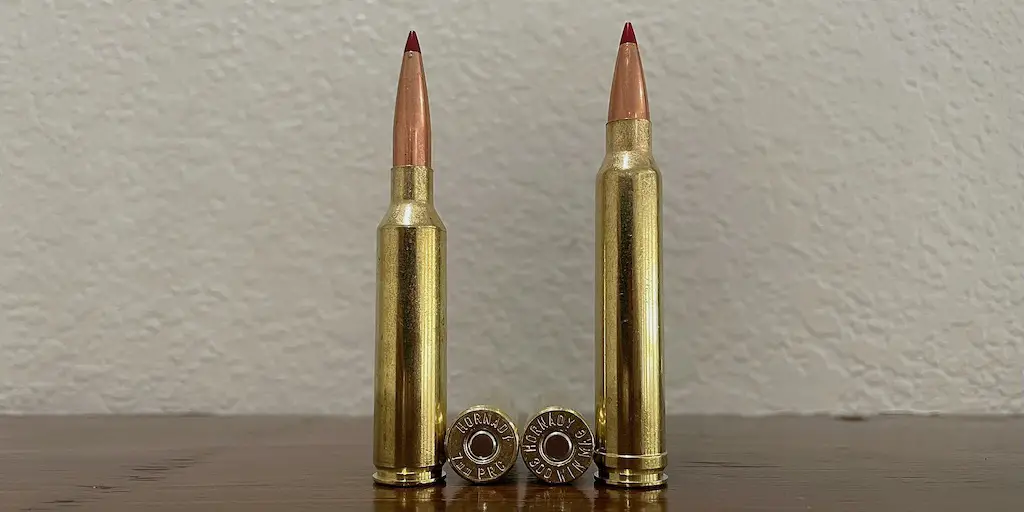
Those factors result in the 7mm PRC having more powder capacity than you might expect, but the 300 Win Mag still can hold about 10% more powder than the 7mm PRC as a result of its much longer case length.
The 7mm PRC also has a longer case neck than the 300 Win Mag (.2868″ vs .264″). We’ll discuss the implications of this difference in more detail later on as well.
Bullet weight and bullet diameter are two other important differences between the 7mm PRC vs 300 Win Mag.
First, the 7mm PRC uses .284″ bullets while the 300 Win Mag uses larger diameter .308″ bullets.
The 7mm PRC normally uses bullets in the 150-180 grain range, with 160 grain bullets, 175 grain bullets, and 180 grain bullets being most common. Specifically, designers at Hornady built the 7mm PRC to use high BC 160gr monometal and 175gr and 180gr lead core bullets from the beginning.
On the other hand, 300 Win Mag factory loads typically use bullets in the 150-200 grain range. 150 grain, 165 grain, 168 grain, 180 grain, 190 grain, and 200 grain loads are the most common for this cartridge.
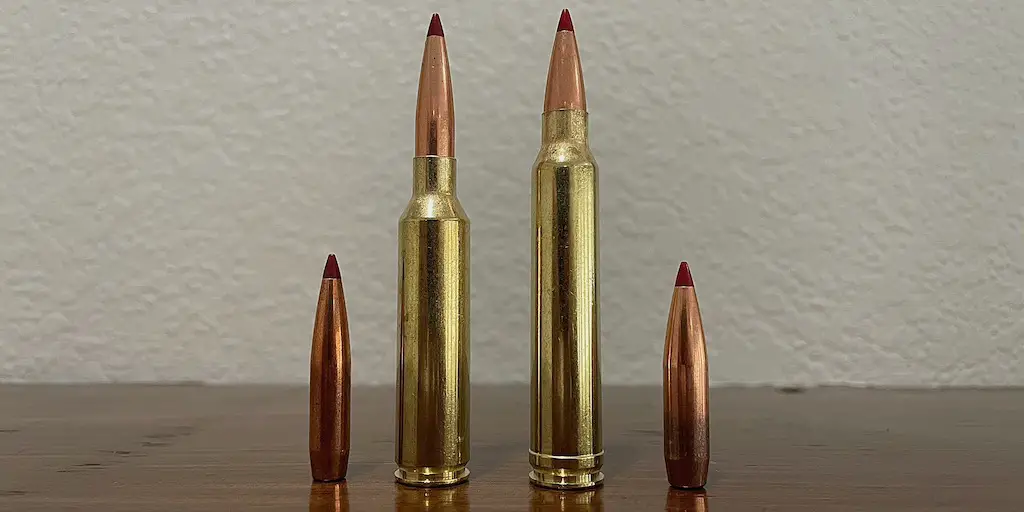
We’ll discuss the impacts of these differences in bullet diameter and bullet weight in more detail later in this article.
Finally, the 7mm PRC is loaded to a slightly higher SAAMI maximum average pressure of 65,000psi vs 64,000psi for the 300 Win Mag.
Note: while the powder capacity figures listed below do give a good indication of the differences between the two cartridges, exact case capacities vary slightly according to the brand of brass used.
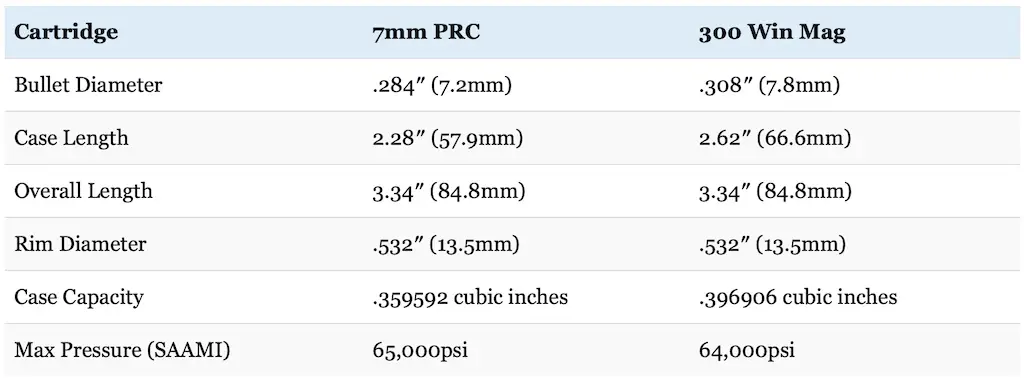
300 Win Mag vs 7mm PRC Ballistics
The differences in the external dimensions of these cartridges also translate into some very interesting differences in their ballistic performance. Fortunately, both cartridges are available in multiple different factory loads to assist in conducting an apples-to-apples comparison.
This is illustrated in the table below comparing Federal Terminal Ascent, Hornady Outfitter, and Hornady Precision Hunter factory loads for both cartridges.
The 7mm Precision Rifle Cartridge loads use 160gr CX (.596 BC), 170gr Terminal Ascent (.646 BC), and 175gr ELD-X (.689 BC) bullets.
The .300 Winchester Magnum loads use 180gr CX (.469 BC), 200gr Terminal Ascent (.608 BC), 178gr ELD-X (.552 BC), and 200gr ELD-X (.597 BC) bullets.
Yes, Hornady’s Precision Hunter line actually has 300 Win Mag loads using both 178gr and 200gr ELD-X bullets and I included both loads in this comparison.
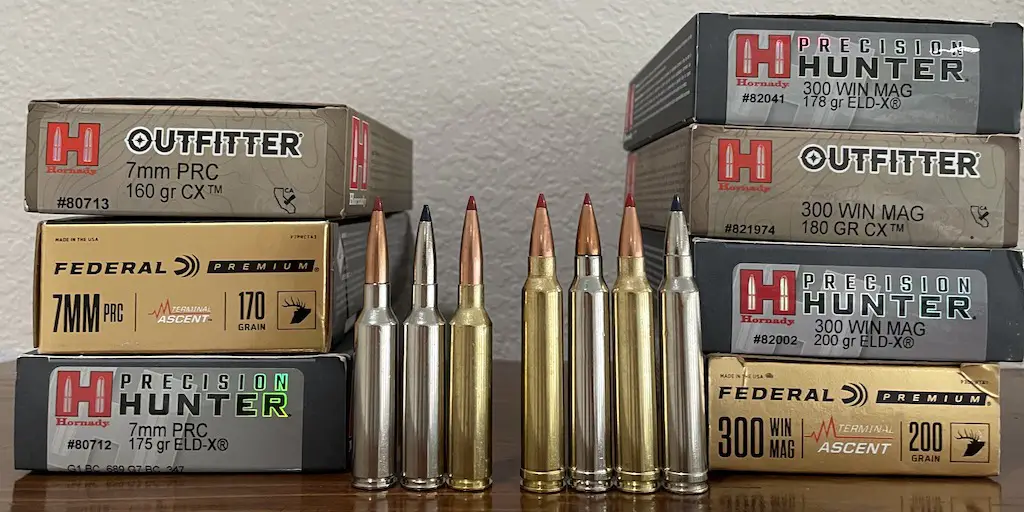
Note: the CX is a lead free monolithic projectile designed by Hornady to deliver high weight retention and deep penetration. However, as a monolithic projectile, those bullets do not have nearly as high of a BC as the ELD-X or Terminal Ascent projectiles.
Additionally, Federal advertises the Terminal Ascent requires a minimum impact velocity of 1,350-1,400fps for expansion. However, Hornady recommends at least 1,600fps of impact velocity for the ELD-X and at least 2,000fps of impact velocity for the CX.
Finally, I want to point out that the various bullets used in those 7mm PRC loads all have a higher BC than those used in the comparable .300 Winchester Magnum loads.
All seven loads used a 200 yard zero.
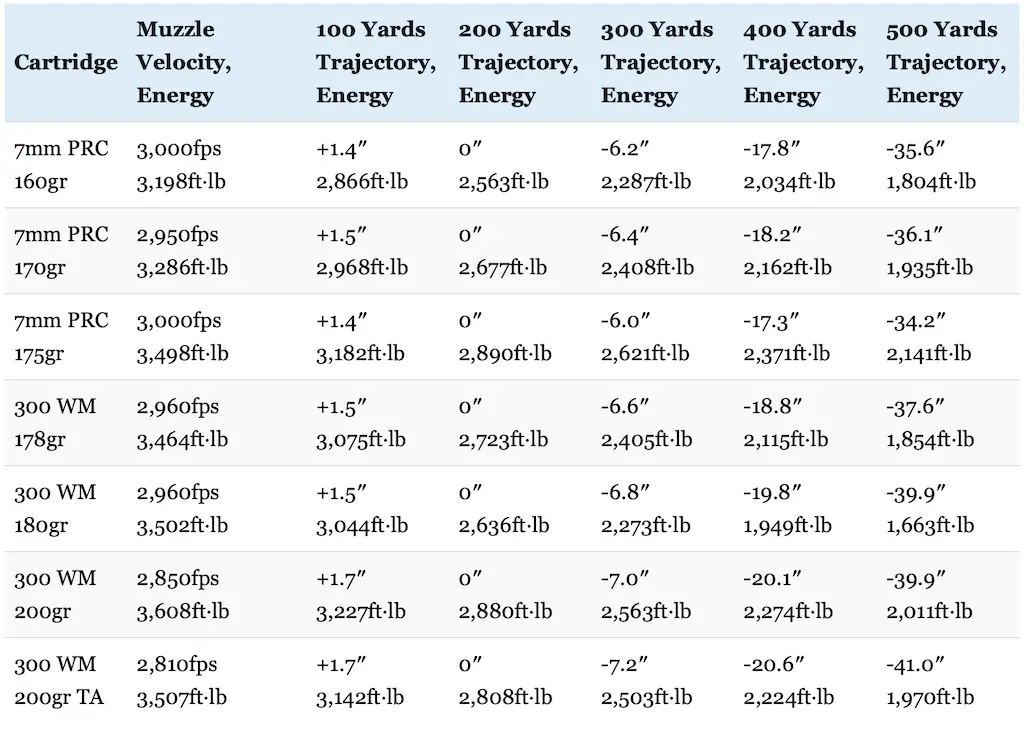
As you can see, the three 7mm PRC loads are the flattest shooting loads of the bunch. Though the 178gr ELD-X load for the 300 Win Mag comes close, it still has about a 1.5″ more bullet drop than the 170gr Terminal Ascent load, 2″ more drop than the 160gr CX load, and 3.4″ more bullet drop than the 175gr ELD-X load at 500 yards.
That really says something when a monometal bullet like the 160-grain CX is shooting flatter than lead core projectiles in the 300 Win Mag, which is itself a high performance cartridge.
This is due to the fact that all three 7mm PRC loads have a higher muzzle velocity than the comparable 300 Win Mag loads and shoot bullets with an even higher BC. Heck, with the exception of the 170gr Terminal Ascent load for the 7mm PRC (which is going just 10fps slower than the 178gr and 180gr 300 Win Mag loads) every 7mm PRC load is faster than every 300 Win Mag load!
We’re not talking about a tremendous difference here (~150fps in most cases), but this is one of those comparisons where we’ll be doing a lot of hair splitting and the respective advantages and disadvantages of each cartridge will be determined on the margins.
However, all seven of these loadings (but especially the 7mm PRC loads) are relatively flat shooting and just 6.8″ separates the flattest shooting 7mm PRC load from the most arching 300 Win Mag load at 500 yards.
On the other hand, the 300 Win Mag loadings generally have more muzzle energy than the comparable 7mm PRC loads (the most powerful 7mm PRC load in the 175gr ELD-X has a 34ft-lbs or about 1% more muzzle energy than the least powerful 300 Win Mag loading with the 178gr ELD-X).
The situation changes as we go downrange though as the higher BC 7mm PRC loads start to overtake their comparable 300 Win Mag loads in terms of kinetic energy.
Things are somewhat of a mixed bag at 500 yards: the 175gr ELD-X load for the 7mm PRC has the most retained energy of the group, but the 200gr ELD-X is #2 in this category, the 160gr CX load has surpassed the 180gr CX load, and the 170gr Terminal Ascent has nearly caught the 200gr Terminal Ascent.
All things considered, both cartridges are still performing great here and every single load for both cartridges carries over 1,600 ft-lbs of kinetic energy out past 500 yards (over 1,800ft-lbs in the case of everything but the 180gr CX for the 300 Win Mag, and over 2,000ft-lbs for the 175gr and 200gr ELD-X loads).
Here’s how each 7mm PRC load compares individually to the comparable 300 Win Mag load in terms of muzzle energy, retained energy at 500 yards, and bullet drop at 500 yards:
Federal Terminal Ascent: the 300 Win Mag has 6.7% more muzzle energy, 1.8% more kinetic energy at 500 yards, and 4.9″ (13.5%) more bullet drop at 500 yards.
Hornady Outfitter: the 300 Win Mag has 9.5% more muzzle energy, the 7mm PRC has 8.5% more kinetic energy at 500 yards (the 7mm PRC overtakes the 300 Win Mag here just shy of 300 yards), and the 300 Win Mag has 4.3″ (12%) more bullet drop at 500 yards.
Hornady Precision Hunter: the 178gr and 200gr 300 Win Mag loads have 1% less and 3.1% more muzzle energy respectively, the 7mm PRC has 6.5% more kinetic energy than the 200gr ELD-X and 15.5% more retained energy than the 178gr ELD-X at 500 yards (the 7mm PRC starts off with more energy than the 178gr ELD-X and overtakes the 200gr ELD-X here just shy of 200 yards), and the 178gr and 200gr 300 Win Mag loads have 3.4″ (10%) and 5.7″ (17.2%) more bullet drop at 500 yards respectively.
So, the big takeaways so far are that the 7mm PRC is generally a flatter shooting cartridge that often retains more energy at longer range, but the 300 Win Mag is harder hitting up close and still holds its own pretty well as ranges increase.
Those trends continue as we look out to even longer ranges. Note that I’m not advocating using either cartridge for hunting at extreme range, but things start to get pretty interesting as ranges increase.
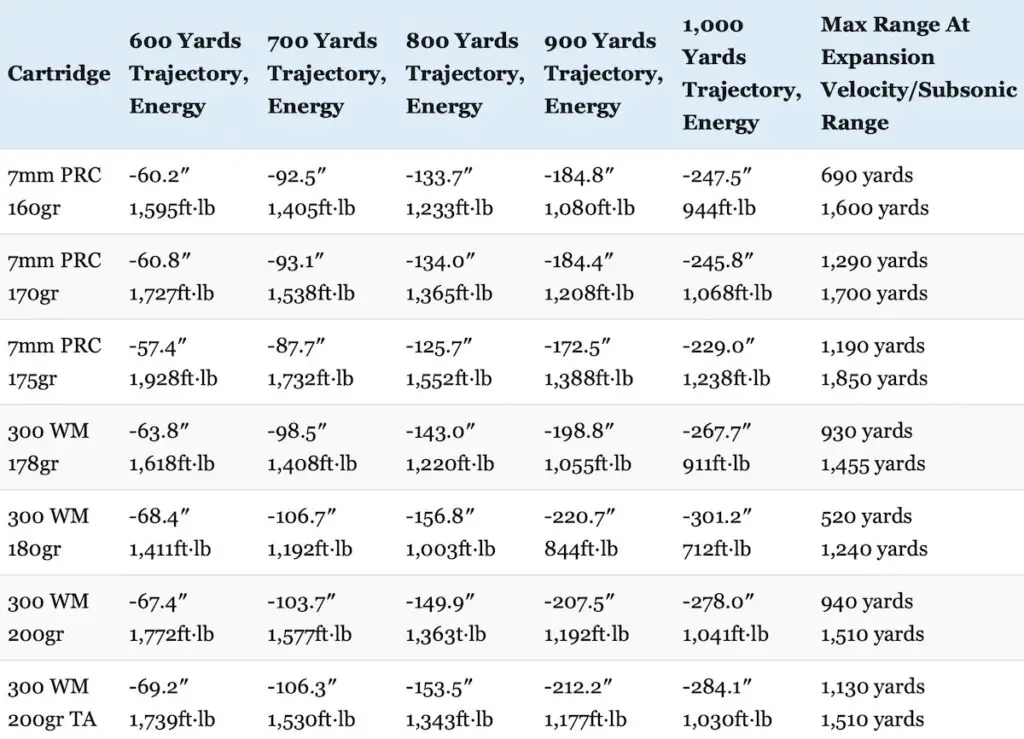
The 7mm PRC has the flattest trajectory of the bunch and every 7mm PRC load has less bullet drop at 1,000 yards than every 300 Win Mag load.
All the 7mm PRC loadings have more kinetic energy than the comparable 300 Win Mag loads in terms of retained kinetic energy as well. The Outfitter and Precision Hunter loads for the 7mm PRC accomplish this feat by 200-300 yards and the 7mm PRC Terminal Ascent loading passes the 300 Win Mag loading just shy of 700 yards.
Indeed, the #1 and #2 loads in this comparison in terms of retained energy are the 175gr ELD-X and 170gr Terminal Ascent for the 7mm PRC (the 170gr TA pulls ahead of the 200gr ELD-X around 800 yards).
The 200gr ELD-X is #3, the 200gr Terminal Ascent is #4, the 160gr CX is #5, the 178gr ELD-X is #6, and the 180gr CX is #7.
175gr ELD-X loading for the 7mm PRC has 18-20% more kinetic energy remaining at 1,000 yards than both 200gr loadings for the 300 Win Mag. Even the lower BC 170gr Terminal Ascent has 2.5-3.7% more retained energy than the 200gr 300 Win Mag loads.
Once again, this is because those 7mm PRC bullets have the two highest BCs of all the bullets used in this comparison which results in them to retaining energy and velocity better than everything else.
Even that 160gr CX loading for the 7mm PRC still carries over 1,500 ft-lbs of kinetic energy out past 500 yards, over 1,000 ft-lbs of energy out past 900 yards, and doesn’t dip below its minimum recommended impact velocity until nearly 700 yards, which is a substantial improvement over the 180gr CX loading for the 300 Win Mag.
Now let’s talk about another important factor: wind.
The chart below compares how much a 10 mile per hour crosswind impacts those same 300 Win Mag and 7mm PRC loads out to 500 yards.
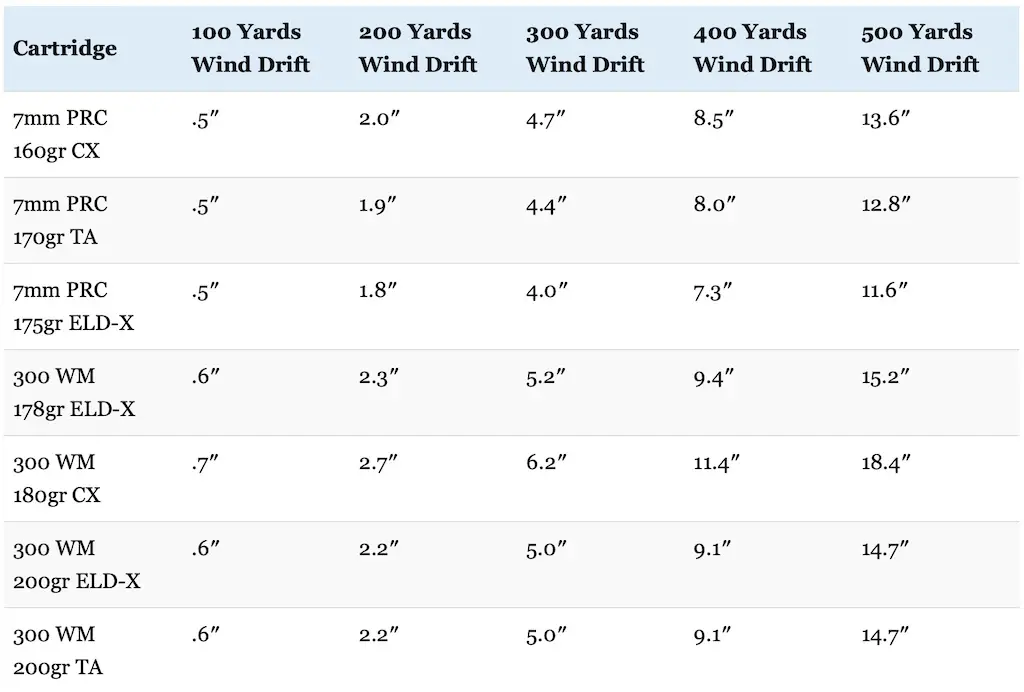
Those same general trends hold true with regards to wind deflection, but this is where the 7mm PRC stands apart from the 300 Win Mag.
The 7mm PRC ELD-X has the least wind deflection, followed by the 170gr Terminal Ascent, the 7mm PRC 160gr CX load, both 200gr 300 Win Mag loads, the 178gr ELD-X for the 300 Win Mag, and finally the 180gr CX.
While all of these loads (but to a lesser extent with the 180gr CX) have great wind bucking characteristics, I was especially impressed with how well the 7mm PRC performed here and all three loads for that cartridge had better performance in the wind than all of the 300 Win Mag loads.
I’d go so far as to say that having approximately one foot of wind deflection at 500 yards with a 10 mph full value crosswind like the 175gr ELD-X and 170gr Terminal Ascent is absolutely outstanding. Indeed, that 175gr ELD-X loading for the 7mm PRC delivers some of the best performance in windy conditions currently available for any big game hunting ammo right now.
While that 3.1″ of difference in wind deflection between the 175gr ELD-X and the 200gr Terminal Ascent and ELD-X loads from the 300 Win Mag at 500 yards might not sound like a tremendous amount, that’s still a 26% advantage in favor of the 7mm PRC.
The 170gr Terminal Ascent doesn’t perform quite on the level of the 175gr ELD-X here, but it still has a 15% advantage over the best performing 300 Win Mag loads in this area.
Those differences become even more apparent at longer range too.
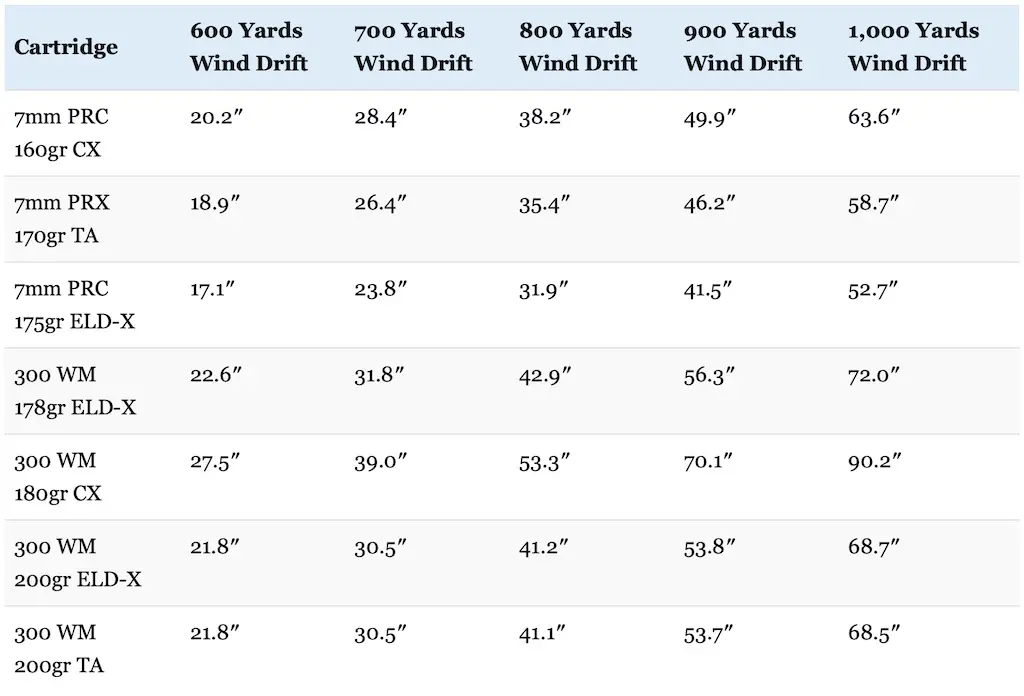
For instance, the advantage that 175gr ELD-X load has over the 300 Winchester Magnum continues to grow as the range increases.
This is an area where the 7mm PRC really shines with a combination of a high muzzle velocity and a very high BC bullet in the 175gr ELD-X (and to a lesser extent with the 170gr Terminal Ascent).
Indeed, it performs a lot better than most comparable loadings at extended range and a hunter or shooter looking for that little bit of an advantage would be well served to look at the either the Terminal Ascent or ELD-X loadings for the 7mm PRC here.
Why is this the case?
Assuming the same wind conditions, wind deflection is dependent on bullet velocity and BC. However, small changes in ballistic coefficient result in bigger changes in wind deflection than is the case with velocity.
For this reason, the 7mm PRC load firing the super high BC 175gr ELD-X at a faster velocity comes out on top here with the 170gr Terminal Ascent a close second.
I wouldn’t say the 300 Win Mag does poorly here and it still holds its own pretty well. However, .30 caliber cartridges in general tend to lag behind 7mm cartridges in this area because the latter are better suited for use with extremely high BC bullets.
Case in point: even the highest BC 300 Win Mag 200gr ELD-X and 200gr Terminal Ascent loads still fall short of the 160gr CX load for the 7mm PRC (which is a lead free bullet).
External ballistics don’t tell the whole story though and there’s more to picking a hunting cartridge than kinetic energy, bullet drop, or wind drift at various ranges.
For instance, now let’s talk about recoil.
The table below compares the recoil produced by handloads that are very similar to the 175gr and 200gr loads for the 300 Win Mag and 7mm PRC respectively when fired from identical rifles.
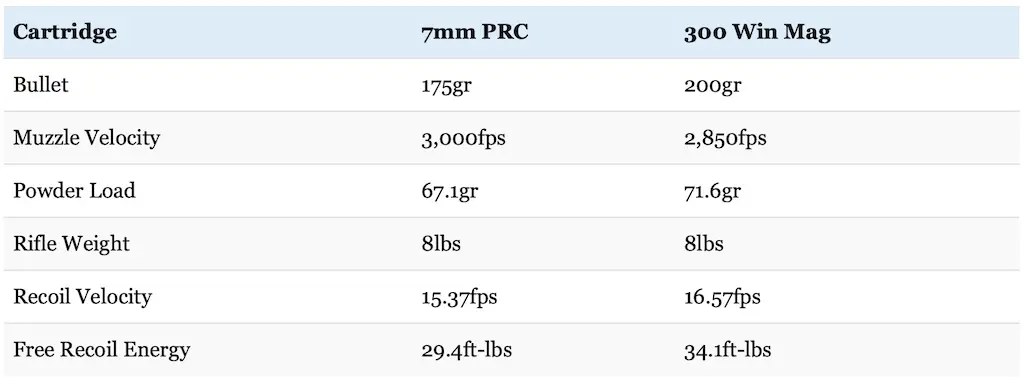
Felt recoil will vary from shooter to shooter and rifle to rifle, but free recoil energy is still a useful way to compare cartridges.
As you can see, the both cartridges have fairly stout recoil, but the 300 Win Mag has quite a bit more recoil than the 7mm PRC with this particular loading.
Even though it has a slightly slower muzzle velocity, that 300 Win Mag load fires a heavier bullet and uses more powder to achieve that performance. For this reason, the 300 Win Mag has about 16% more free recoil energy than the 7mm PRC.
I would not say either cartridge has a tremendous amount of recoil. I’ve shot and hunted with both the 7mm PRC and the 300 Win Mag pretty extensively.
Recoil produced by these loads are on the stout side, but neither is especially painful or difficult to shoot.
And yes, my experience afield and at the range more or less matches those figures I just showed you: my 7mm PRC has quite a bit less recoil than typical .300 Win Mag loads.
Though the 7mm PRC does indeed have less recoil, I feel like both the 7mm PRC and 300 Win Mag are cartridges that have the sort of recoil that many people can handle without a lot of trouble, especially when shooting a rifle that fits them well, that has a good recoil pad, or is equipped with a muzzle brake or suppressor.
Even so, it’s still worth mentioning that the 7mm PRC does kick less than the 300 Win Mag.
Don’t underestimate the impact that recoil has on the ability of a person to shoot accurately either. Some people do handle recoil better than others, but all other things being equal, they will absolutely shoot more accurately with a milder recoiling cartridge.
Additionally, there are a couple of other factors that are also worth discussing.
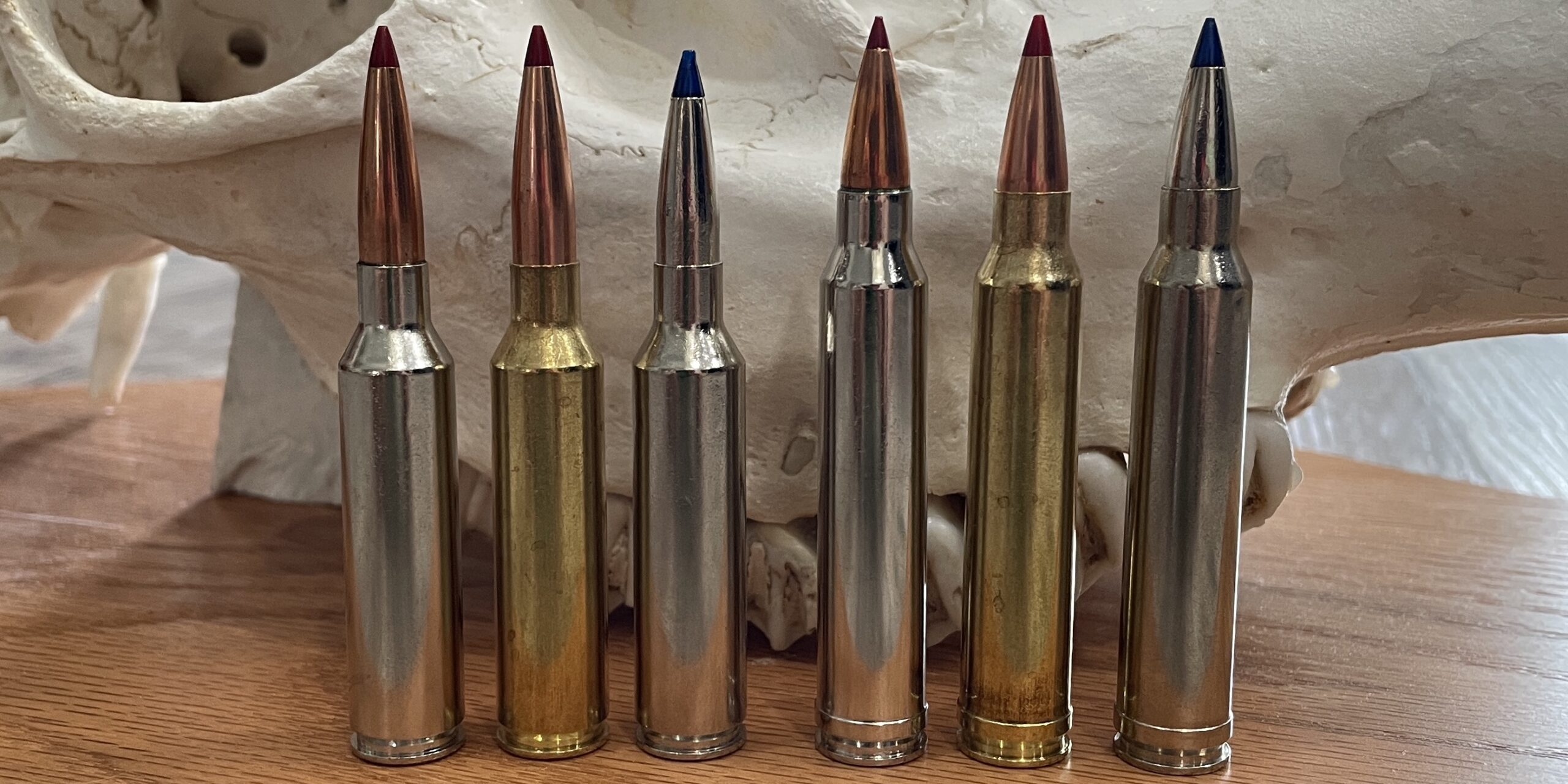
First, the 300 Win Mag uses larger diameter bullets than the 7mm PRC .
Specifically, the larger diameter .308″ bullets used by the .30 caliber cartridge have about 18% more frontal surface area (also known as cross sectional area) than the .284″ bullets used by the 7mm PRC (.0745 vs .0633 square inches). All other things being equal, a bigger bullet will make a bigger hole, cause more tissue damage, and result in more blood loss.
This is a significant advantage in favor of the 300 Winchester Magnum and those larger diameter bullets can certainly also be helpful when hunting big game.
On the other hand, as we covered earlier, many of those longer, heavy for caliber .284″/7 mm bullets the 7mm PRC uses have a higher ballistic coefficient than the most common .308″ bullets used in the 300 Winchester Magnum, especially when bullet weights are similar.
For instance, the .308″ 178gr ELD-X, 200gr ELD-X, and 200gr Terminal Ascent bullets used by the 300 Win Mag have G1 BCs of .552, .597, and .608 respectively. Those bullets have very high BCs themselves, but still fall a little short of the .284″ 175gr ELD-X and 170gr Terminal Ascent used by the 7mm PRC with a G1 BC of .689 and .646 respectively.
As another example, that .284″ 160gr CX has a G1 BC of .596 which handily outclasses the .469 BC of the .308″ 180gr CX.
While this is generally the case, there are exceptions and Remington’s Premier Long Range line of ammo is an example with a 175gr Speer Impact (.549 BC) for the 7mm PRC and a 190gr Speer Impact (.596 BC) for the .300 Win Mag.
While those differences are indeed (usually) small in favor of the 7mm PRC, they are still worth considering because those slightly more aerodynamic projectiles don’t slow down as fast and are more resistant to wind drift.
Calculating holdover is a pretty simple proposition these days for hunters using good laser rangefinders paired with ballistic turrets for their scope and/or ballistic calculator smartphone apps.
Determining an appropriate wind hold is much more challenging though.
This is where a cartridge like the 7mm PRC has a real advantage because those high velocity, high BC bullets that resist wind deflection exceptionally well are more forgiving of wind direction and/or wind speed estimation errors.
Additionally, the 7mm Precision Rifle Cartridge has an advantage over the 300 Winchester Magnum in terms of bullet sectional density (SD) in most cases.
Sectional density (SD) is a measure of the ratio of the diameter of a projectile to its mass. All other things equal, a heavier projectile of a given caliber will be longer and therefore have a higher sectional density and consequently penetrate deeper than projectiles with a lower mass and sectional density.
150 grain, 168 grain, 180 grain, 190 grain, and 200gr .308″ bullets have sectional densities of .226, .253, .271, .286, and .301 respectively. At the same time, 160 grain, 170 grain, and 175 grain .284″ bullets have sectional densities of .283, .301, and .310.
So, the heaviest .300 Win mag bullets will have a small edge over the lighter 7mm PRC bullets, but the 7mm PRC generally uses higher sectional density bullets.
We need to discuss the elephant in the room here though: its higher sectional density notwithstanding, the ELD-X is a controversial bullet to say the least.
Some hunters love it.
Others hate it and claim it’s just a “match bullet with a different package.”
The bullet has some undeniable advantages in terms of BC, accuracy potential, and terminal performance at extended range, but I also admit the ELD-X is a very soft bullet.
Candidly, it’s a little too soft in my opinion for use at closer range, especially on bigger game.
Can you cleanly kill game with it? Of course!
Is it my favorite bullet to use in a situation where I might get a closer range shot?
No.
I personally really like the Terminal Ascent and I think it’s a great hunting bullet that delivers outstanding performance at extended range without sacrificing short range performance either.
Fortunately, that bullet is available in both the 7mm PRC and the 300 Win Mag in factory ammunition.
The Terminal Ascent is generally a tougher bullet than the ELD-X because it has a bonded core and a solid rear shank (both of which the ELD-X lacks). When comparing apples to apples here, the .30 caliber 200 grain and 7mm 170 grain Terminal Ascent bullets have the same sectional density of .301.
However, that heavier 200gr Terminal Ascent bullet has more momentum than the 170gr Terminal Ascent and will likely penetrate a little better at all typical hunting ranges.
On the other hand, go back and look at those ballistic charts and you’ll see that, while it lags a little behind the 175gr ELD-X on paper, the 170gr Terminal Ascent also delivers wonderful performance across the board: a flatter trajectory, similar retained energy (and more retained energy past 700 yards), better performance in windy conditions, and less recoil than the 200gr Terminal Ascent.
I’d still say the 300 Win Mag is a heavier hitter for most people, most of the time (and I wouldn’t think anyone was making a mistake by hunting with one), but the 7mm PRC punches well above its weight in terms of terminal performance while at the same time offering some undeniable advantages in trajectory, wind deflection, and recoil than can all assist the shooter in shot placement.
That brings me to my next point.
300 Win Mag vs 7mm PRC Accuracy
What about 7mm PRC vs 300 Win Mag accuracy?
While external ballistics are extremely important, performance on paper doesn’t mean a darn thing if you can’t hit your target.
John Snow wrote a fantastic article on this subject for Outdoor Life, but long story short, companies designing new cartridges these days typically employ more modern cartridge design principles that incorporate best practices obtained from competition and benchrest shooters to obtain the best possible accuracy.
Cartridges designed using these principles use faster twist rates to stabilize heavy, high BC bullets, have cases with a long enough neck to support those longer, high BC bullets, can seat those long, high BC bullets to the SAAMI specified maximum overall length without intruding into the powder column, employ minimal body taper, headspace off sharp shoulders, and have a chamber design with a snug throat.
Taken together, these design principles result in cartridges with a very high degree of accuracy potential, especially at extended range.
Like I mentioned earlier, the 7mm PRC design incorporates all of those principles.
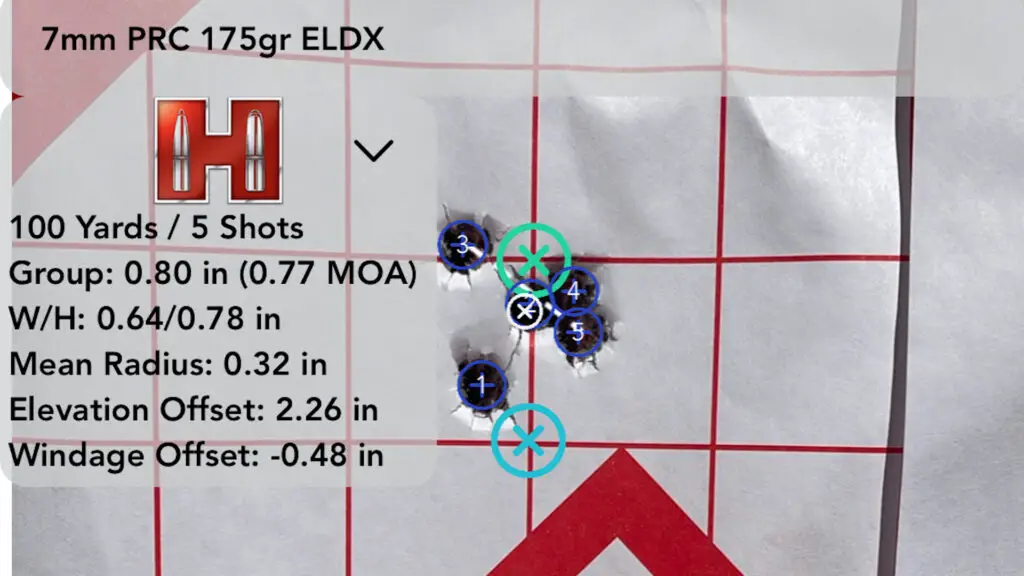
Let’s drill down into things in more detail.
First, the throat is the smooth portion of a rifle barrel closest to the cartridge. Having a more snug throat diameter means there’s less room for the bullet to yaw upon firing before engaging the rifling, which can help enhance accuracy.
Well, the 7mm PRC has a throat diameter just .0006″ larger than the bullet diameter.
That is a very “snug” throat diameter compared to older cartridges like the 243 Winchester (.0033″) or .30-06 (.0026″).
What about the 300 Win Mag? Well that cartridge has a .007″ throat diameter, which has over 11x as much “slop” around the bullet than is the case with the 7mm PRC.
Additionally, the 7mm PRC utilizes a case with less body taper and steeper 30 degree shoulder. Both of these characteristics result in better cartridge alignment in the chamber and more consistent headspacing.
The 7mm PRC also has a faster SAAMI spec rifling twist of 1:8″ (vs 1:10″ for the 300 Win Mag) and also has more head height combined with a longer case neck. All of those things facilitate use with those long, heavy, high BC bullets I keep talking about.
Taken together, all of these individual factors result in excellent accuracy potential for the 7mm PRC, especially with long, heavy, high BC bullets.
Which one is better?
Both are capable of excellent accuracy, but I have to give the advantage to the 7mm PRC here.
That pains me to say because I’ve shot the .300 Win Mag a lot over the years (and done so with some pretty accurate rifles) and have a lot of affinity for the cartridge. Even so, I’d say that on average, the 7mm PRC has better accuracy potential with factory rifles and ammunition.
Details will vary on the exact rifle, ammunition, and shooter in question though and yes, I admit that there will be occasional instances of 300 Win Mag rifles shooting better than 7mm PRC rifles.
And yes, users can work around many of these problems with custom 300 Winchester Magnum rifles, magazines, and handloads designed to accommodate higher BC bullets.
Or they can skip all that hassle and just get a factory 7mm PRC (or 300 PRC) rifle.
However, I still think the 7mm Precision Rifle Cartridge probably has some of the best potential for accuracy available today using factory rifles and ammunition.
So where do we stand overall?
7mm PRC vs 300 Win Mag
The 7mm PRC fires smaller diameter bullets that usually have a higher BC and a faster velocity than the 300 Win Mag. The 300 Win Mag typically has more recoil and more kinetic energy up close, but the 7mm PRC has a flatter trajectory, better resistance to wind deflection, and more kinetic energy at extended range.
300 Win Mag vs 7mm PRC Ammo
Of the two, the 300 Win Mag is still easily the most popular and widely available cartridge. In fact, the 300 Win Mag usually ranks among the Top 10 best selling rifle cartridges in the United States each year.
For example, MidwayUSA currently lists 76 300 Winchester Magnum loads, but only 6 7mm PRC loads as I type this.
Pretty much every ammunition manufacturer of note like Barnes, Berger, Black Hills, Browning, Federal, Hornady, HSM, Nosler, Norma, PPU, Remington, Sierra, Sellier & Bellot, Swift and Winchester (just to name a few) produce a wide variety of ammo for the .300 Win Mag.
Since the .300 Win Mag uses .308 cal bullets, virtually every major style of hunting bullet is available in this cartridge: the Winchester Power Point, the Federal Trophy Copper, the Remington Core Lokt, the Barnes TTSX, the Hornady CX, ELD-X, ELD Match, and InterLock, the Nosler AccuBond, AccuBond Long Range, Ballistic Tip, and Partition, the Federal Terminal Ascent, Fusion Soft Point, and Power Shok soft point, etc.
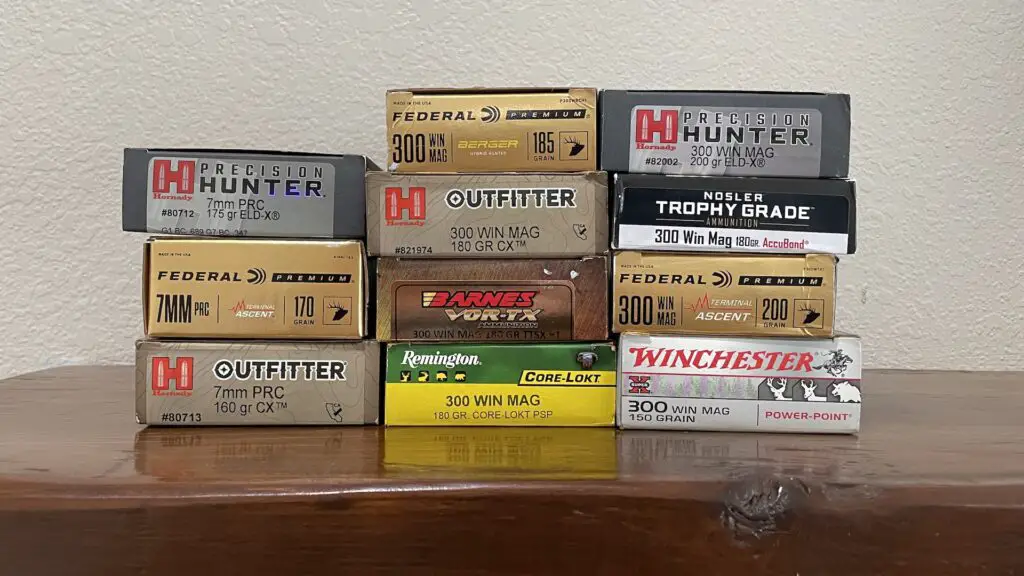
On the other hand, the 7mm PRC is literally brand new, but has become extremely popular in an astonishingly short amount of time.
Hornady was the first company to manufacture factory 7mm PRC ammo. They currently offer three loads for the cartridge: an offering in their Match line loaded with a 180 grain ELD Match bullet, an offering in their Outfitter line with a 160 grain CX bullet, and an offering in their Precision Hunter line with a 175-grain ELD-X bullet.
While that Match ammo is great for use at the range, I prefer the Outfitter and Precision Hunter 7 mm PRC loads for hunting. Both loads are excellent for hunting all manner of game in North America and elsewhere in the world.
Federal also recently started making 7mm PRC ammo as well in their Premium and Terminal Ascent lines using the 175gr ELD-X, the 155gr Terminal Ascent, and the 170gr Terminal Ascent. Remington also recently picked up the cartridge and now offers 7mm PRC factory ammo loaded with a 175gr Speer Impact bullet in their Premier Long Range line.
Federal and Remington also announced new 7mm PRC ammunition offerings at the 2024 SHOT show in their Tipped Fusion, Core Lokt Tipped, and CuT lines.
Nosler also rolled out a 7mm PRC factory load with a 175gr AccuBond Long Range in early 2024 as well.
Furthermore, 7 mm PRC ammo prospects are looking great in the near future and there are also rumblings that other companies (like Barnes) will pick up the cartridge as well.
If you’d like to learn more about some of the various hunting ammunition choices for the 7mm PRC or 300 Win Mag cartridges, read the articles below:
Best 7mm PRC Ammo For Hunting Elk, Deer, Bear, & Other Game
Best 300 Winchester Magnum Ammo For Hunting Moose, Elk, Deer, & Other Game
Handloaders will appreciate the fact that reloading components for these cartridges are available and there’s an excellent variety of bullet choices for each cartridge. So, you should not have any trouble working up a good custom load for either one if you like to handload.
The 7mm PRC all uses the same .284″ bullet size as other popular 7 mm cartridges like the 7mm-08, 280 Remington, 280 Ackley Improved, 7 mm Remington Magnum, 7mm SAUM, 7mm WSM, 7 mm STW, 28 Nosler, and 7mm Weatherby Magnum (among others).
Likewise, the .300 Win Mag uses the same .308 cal bullets as other popular .30 caliber cartridges like the 30-30 Winchester, 308 Winchester, 30-40 Krag, 30-06 Springfield, 300 RUM, 300 Weatherby Magnum, 30 Nosler, and 300 PRC.
7mm PRC vs 300 Win Mag Rifles
The rifle situation with the 7mm PRC and 300 Win Mag is similar to the ammunition situation: rifles chambered in 300 Win Mag are by far the most common, but there’s also a good (and improving) selection of 7mm PRC rifles.
For example, Sportsman’s Warehouse currently lists 71 7mm PRC rifles and a whopping 334 300 Winchester Magnum rifles as I type this!
Both are very easy to find in bolt-action hunting rifles like the Browning X-Bolt, Christensen Arms Ridgeline, Remington 700, Ruger American, and Savage 110.
The 300 Win Mag is also available in some rifles that are not manufactured in 7mm PRC, like the Browning Lever Action Rifle (BLR), Browning Automatic Rifle (BAR), Browning AB3, Tikka T3x, Howa 1500, Mossberg Patriot, Weatherby Vanguard, and Winchester Model 70.
That list of 7 mm PRC rifles will likely continue to grow as well.
Which one is easier to find?
Things may be different in 10 years, but the 300 Win Mag has easily the best selection of rifles right now.
Next, remember what I mentioned earlier about the 7mm PRC generally having the a faster rifling twist rate?
That’s usually true, but it’s not a hard and fast rule.
For instance, Browning produces their Speed LR and Max LR versions of the X-Bolt in 300 Win Mag with faster 1:8″ twist rates (same as the 7mm PRC SAAMI standard).
This facilitates the use of even longer and higher BC .30 caliber bullets (like the 212gr ELD-X from Hornady with a .663 BC).
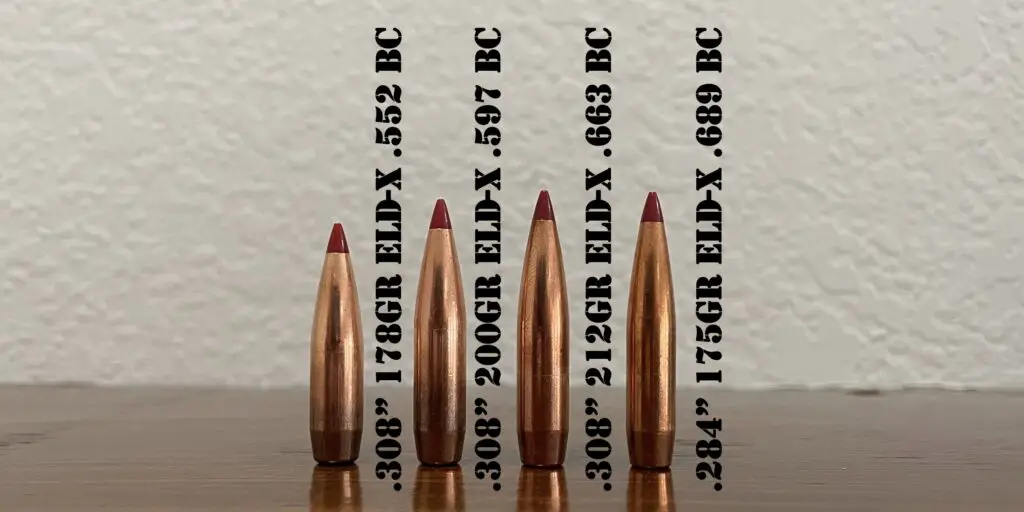
It’s also important to realize that gun manufacturers tend to put longer barrels on rifles chambered in magnum cartridges in general. This is because those cartridges need a longer barrel to effectively and efficiently burn that larger powder charge.
This holds true for both cartridges, but the 7mm PRC works better than the 300 WIn Mag out of shorter barreled rifles.
The 7mm PRC is often available in rifles with 20″, 22″, and 24″ barrels.
The 300 Win Mag is normally available in rifles with a 24″ or even a 26″ barrel. A handful of models have shorter 22 barrels in some cases (though those shorter barrels are somewhat unusual and are most common on “suppressor ready” models).
While the both cartridges are available in rifles of the same size and length, it’s important to note that the 7mm PRC will have a slight advantage over the 300 Win Mag for those looking for a lighter and/or more compact rifle.
Here’s an example that illustrate this point.
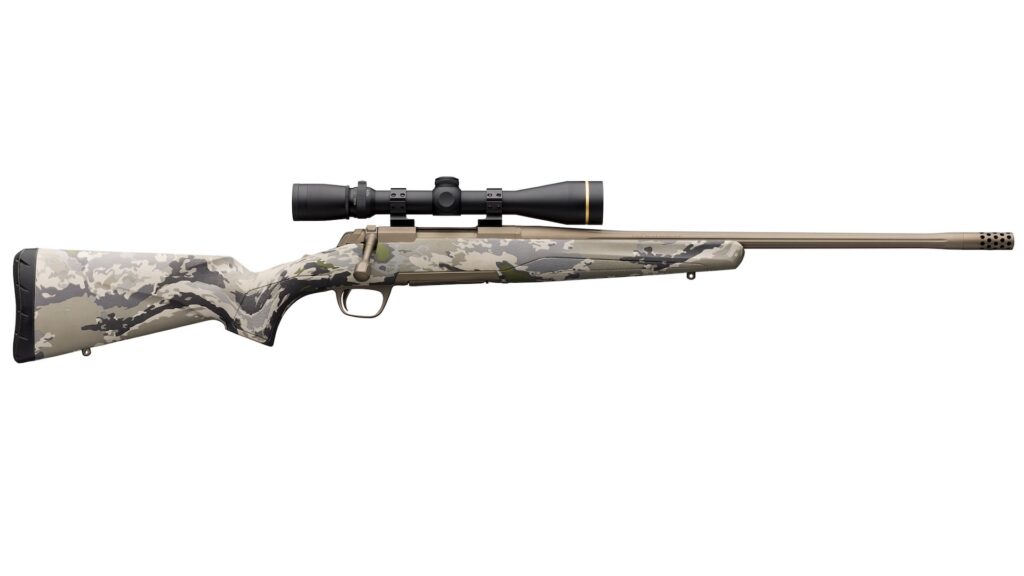
Browning manufactures their X-Bolt Speed Suppressor Ready rifle in both cartridges.
The variant chambered in 7mm PRC has a 20″ barrel and is only 40.75″ long.
The variant chambered in 300 Win Mag has a 22″ barrel and an overall length of 42.75″.
Browning also manufactuers their new X-Bolt 2 Speed in 7mm PRC and 300 Win Mag.
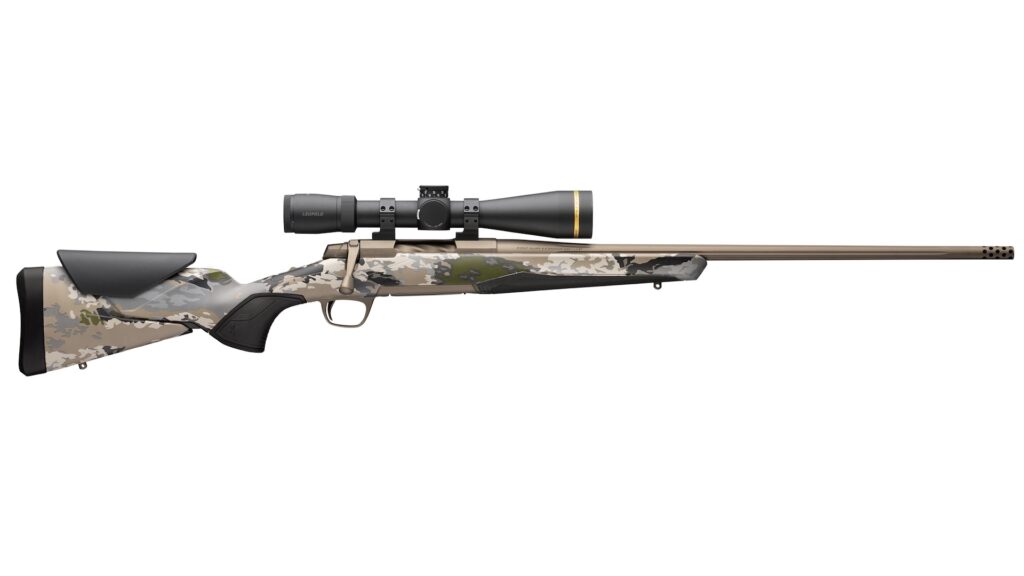
It has a 24″ barrel and is 44.75″ long when chambered in 7mm PRC.
And has a 26″ long barrel and is 46.75″ long when chambered in 300 Win Mag.
Having a shorter and handier rifle is more important on some hunts than on others. So, just keep that in mind.
If you’d like to learn more about some of the various hunting rifle choices for the 300 Winchester Magnum and 7mm Precision Rifle Cartridge, read these articles:
Best 300 Win Mag Hunting Rifles
7mm PRC vs 300 Win Mag: Which Is Right For You?
Before we move on, I have to answer the question: will the 7mm PRC last? Or is it just the latest flash in the pan that will eventually fade away after a couple of years like the 300 SAUM, 7mm Remington Ultra Magnum, and 243 Winchester Super Short Magnum?
Nobody wants to buy a rifle chambered in a new cartridge only for the manufacturer to discontinue production of rifles and factory ammo just a couple of years down the road.
On one hand, I can understand why many people don’t want to use something (especially something new) that’s uncommon. On the other hand, a lot of people have to start using that new cartridge for it to BECOME common.
It’s impossible for me to know for sure, but I wouldn’t be surprised if the 7mm PRC sticks around for the long term.
In fact, I’d pick the 7mm PRC out of all the new cartridges to hit the market in the last 5 years if I had to choose the one most likely to have the best long term success.
I’ve said it before and I’ll say it again: it’s really hard for me to bet against Hornady’s design and marketing teams. Plus, the company also did an outstanding job of getting a large number of other manufacturers to pick up the cartridge right out of the gate.
I’m not exaggerating when I say that I’ve never seen anything explode in popularity quite like the 7mm PRC did.
Get back with me in 10 years and we’ll see how accurate my prediction was!
Now that we’ve got that out of the way, let’s talk about the how each cartridge performs in a couple of different hunting situations.
Do you primarily hunt medium sized game like whitetail deer, pronghorn, feral hogs, or black bear at ranges within 200 yards? Both are extremely effective deer hunting cartridges and will absolutely get the job done on medium sized game if you do your part. There really isn’t a significant difference between the 300 Winchester Magnum and 7mm PRC on deer inside of 200 yards and both are more than powerful enough for that sort of work.
For instance, I took the pronghorn below at about 150 yards with a 165gr Barnes TTSX from my 300 Win Mag and that buck dropped in its tracks.

I also shot this impala (which is about the size of a deer) with my 7mm PRC at about 60 yards with a 160gr CX. That buck staggered at the shot and only ran about 10 yards afterwards.

If you’re going to be hunting in thick brush or in the tight confines of a deer stand, remember what I just mentioned about the barrel length difference with 7mm PRC vs 300 Win Mag rifles. That extra couple of inches in overall length of a rifle can be a real headache to deal with when trying to quickly and quietly maneuver for a shot. Not that either is a “bad” choice here, but of the two, a 7mm PRC rifle with a 20″ or 22″ barrel will definitely be easier to handle than a 300 Win Mag rifle, especially if it has a 26-inch barrel.
At the same time, the 7mm PRC will also be lighter on your shoulder.
Are you looking for the cartridge better suited for long range hunting for game like mule deer or pronghorn antelope in open country where you might need to take a shot at several hundred yards? Once again, they’ll both work really well in this role and situations like these are where they start to stand apart from other cartridges. The 300 Win Mag is a great choice in this role, but the 7mm PRC definitely has the advantage in this area terms of having less recoil, a flatter trajectory, better performance in the wind, and it also carries more energy out to extended range.
Do you want a hunting cartridge that’s well suited for caribou, moose, elk, eland, kudu, or red stag hunting? Again, both will work extremely well when used on bigger game in North America, Africa, Europe, and elsewhere.
Most hunters do not need the long range capabilities of the 7mm PRC and something like the 300 Win Mag or 7 mm Rem Mag will work great for the majority of elk hunting situations.
For instance, I shot this elk at about 40 yards with my 300 Win Mag using a Federal 180gr Federal Trophy Copper load. It only ran about 50 yards afterwards.

Though this situation fell within the window where the 300 Win Mag generally outperforms the 7mm PRC, the newer 7mm PRC still would have done great on that elk under those conditions with the right bullet.
For instance, I took the blue wildebeest (which, though not as big as an elk, is considered one of the toughest species of African plains game) in the photo below with a 160gr CX from my 7mm PRC at about 90 yards. He dropped in his tracks after the shot.
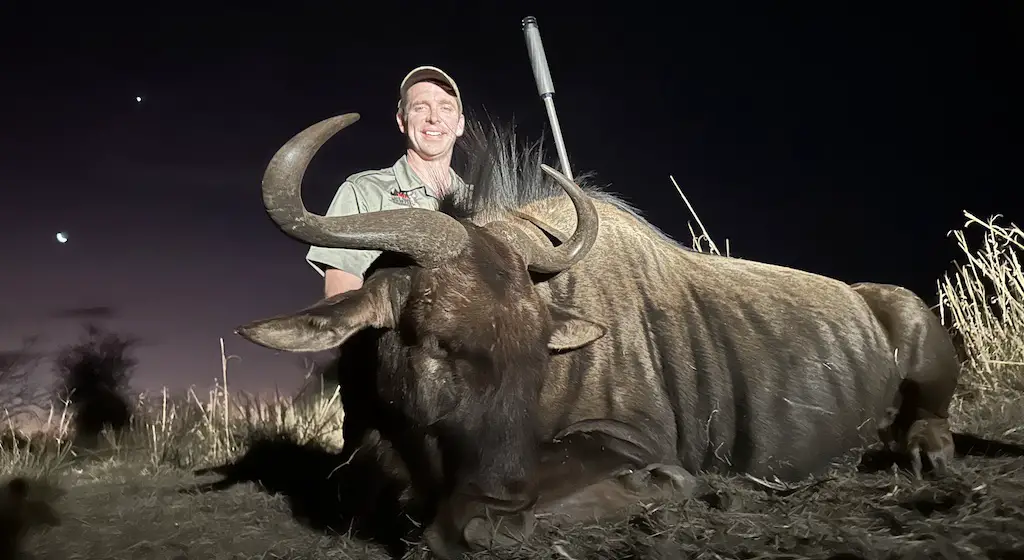
That’s not to say the 300 Win Mag is restricted to use at close range on elk either and (once again, when using the appropriate bullet, like the 200gr Terminal Ascent) the cartridge is deadly on elk about as far away as anybody has any business shooting an elk at.
However, a person with the right shooting skills who wanted to extend their effective range by another couple hundred yards would be well served by the 7mm PRC.
In addition to the fact that the higher BC 7mm PRC offerings retain more energy at extended range, the 7mm PRC also has better resistance to wind across the board. Since windy conditions tend to be pretty common out west, wind resistance for a cartridge should not be overlooked. I wouldn’t blame someone for choosing the 300 Win Mag, but I personally lean towards the 7mm PRC here and I think it’s a good choice for someone who wants a capable all-around hunting rifle for everything from deer up to elk and moose.
This is especially true in situations where longer shots are more likely.
I had a friend take a big bull elk up in Colorado at 800+ yards with a single shot from his 7mm PRC using a 175gr ELD-X. That bull ran just 40 feet after the hit.
Unfortunately, he shot that elk in the evening and didn’t get great trophy photos in the field, but it’s the elk on the left in the photo below (the deer and other elk were taken with a 7mm Rem Mag).
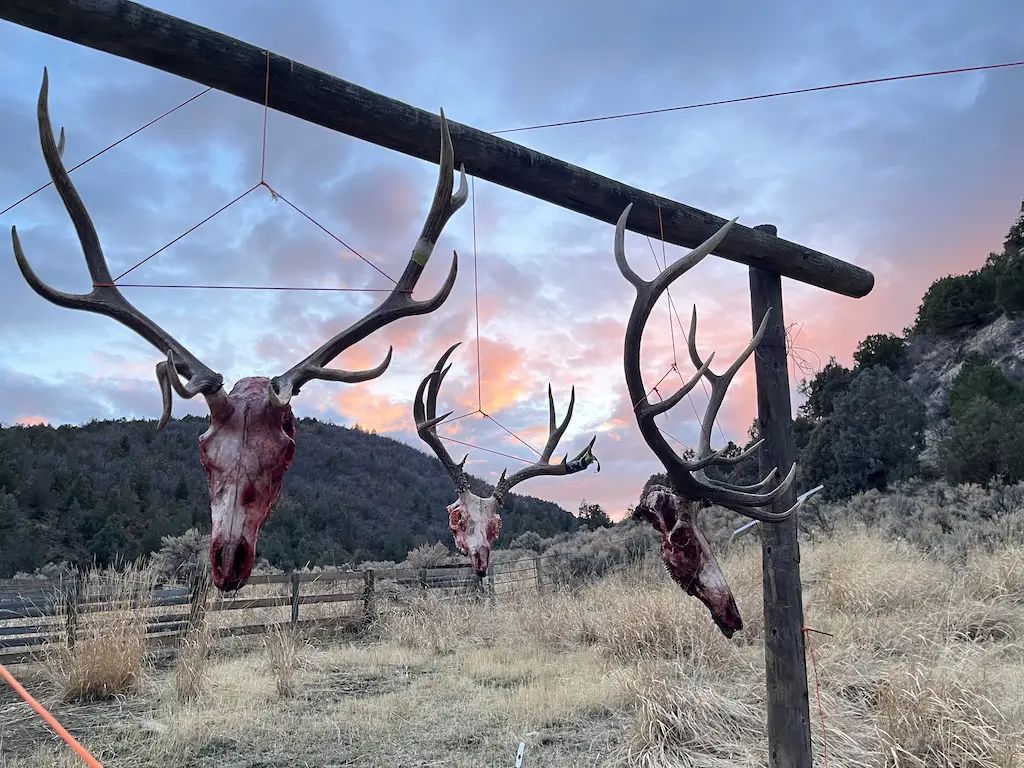
Are you looking for a great cartridge for sheep, mountain goat, or tahr hunting where you need an effective cartridge with manageable recoil in a lightweight and easy to carry rifle? The 300 Win Mag will certainly work, but I’d prefer the 7mm PRC here because it’s available in shorter, lighter, and easier to carry rifles without terrible recoil. The flatter trajectory and better resistance to wind deflection will also come in handy here too and will help the hunter battle potentially challenging environmental conditions to place his/her shot appropriately.
Are you specifically hunting brown or grizzly bear? What if you hunt in Canada or Alaska and need a heavy hitting cartridge just in case you find yourself on the wrong end of a grizzly/brown bear attack? Yes, you can cleanly kill the big bears with either cartridge and numerous people have done exactly that over the years (a 30-06 felled the current B&C record brown bear back in the 1952).
Of the two, I’d much prefer the 300 Win Mag with premium 180gr or 200gr bullets (like a 180gr Barnes TTSX or 180gr/200gr Nosler Partition) if encounters with bigger bears are a possibility. But to be perfectly candid, I do not recommend either cartridge for actually hunting the big bears (the same is true for other species of dangerous game like cape buffalo) and I’d prefer to carry something like a .338 Win Mag, a 375 H&H, or a 375 Ruger in grizzly country.
Are you sensitive to recoil and in need of a serious low recoil cartridge? Both cartridges have fairly stout recoil, but the 7mm PRC is definitely the better choice for a lower recoiling option here.
The 300 Winchester Magnum and the 7mm PRC are both excellent rifle cartridges and it’s tough to pick a clear winner between them. Though the differences between them (7mm PRC vs 300 Win Mag) are fairly significant in certain respects, there is also a good deal of overlap in the situations they’re both suited for. Indeed, both are suitable for many diverse hunting tasks ranging from hunting plains game in Africa and deer in the southern hemisphere to the whole spectrum of North American game.
So, carefully analyze your potential needs before making a decision. In the end, a lot of this decision comes down to personal preference, the exact game you’re after, and the conditions of your hunt. So, choose the one that you feel most comfortable with and it will probably serve you well afield. Good luck!
NEXT: 11 BEST HUNTING EAR PROTECTION OPTIONS FOR SPORTSMEN
NEXT: BEST GIFTS FOR HUNTERS
Enjoy this article comparing the 300 Winchester Magnum and 7mm Precision Rifle Cartridges? Please share it with your friends on Facebook and Twitter.
The Lyman 50th Edition (148-151), Hornady 10th Edition (200-209) were used as references for the history of the cartridges. Hornady provided information for the history of the 7mm PRC. The data used to compare the trajectory and recoil of the cartridges was obtained from Hornady’s web site (here, here, here, here, and here) as well as Federal’s web site (here and here). Maximum pressure and data to compare cartridge sizes for the 7mm PRC vs 300 Win Mag were obtained from SAAMI (here and here on p30). Case capacity information for the 7mm PRC vs 300 Win Mag were obtained from Backfire.TV. Frontal surface area information was obtained from Chuck Hawks. I used Shooters Calculator to compare trajectories, wind drift, and recoil for the cartridges.
Make sure you subscribe to The Big Game Hunting Podcast and follow The Big Game Hunting Blog on Facebook, Instagram, Twitter, and YouTube.
John McAdams is a proficient blogger, experienced shooter, and long time hunter who has pursued big game in 8 different countries on 3 separate continents. John graduated from the United States Military Academy at West Point and is a veteran of combat tours with the US Army in Iraq & Afghanistan. In addition to founding and writing for The Big Game Hunting Blog, John has written for outdoor publications like Bear Hunting Magazine, The Texas State Rifle Association newsletter, Texas Wildlife Magazine, & Wide Open Spaces. Learn more about John here, read some of John’s most popular articles, and be sure to subscribe to his show: the Big Game Hunting Podcast.

